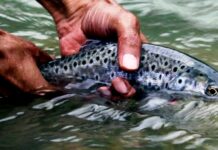by Insha Shirazi
SRINAGAR: In a surprising turn of events, an alligator gar fish (Atractosteus spatula), native to North America, was discovered in Kashmir’s Dal Lake last week, raising concerns about its impact on the local ecosystem. The carnivorous nature of this exotic fish, with its alligator-like head and pointed teeth, has sparked mixed reactions among scientists and the public alike.
Masood Ahmad Khan, who oversees research and monitoring for the Lakes Conservation Management Authority, said that they will consult the fisheries division and SKUAST to determine the effects of the fish’s presence on the lake and its environment.
“The fish appeared abruptly on the conveyor belt while our harvester was working nearby the SKICC (Kashmir International Conference Complex), and we are unsure of the lake from which it originated. Schizothorax Niger is one of the main fish species that can be found in Dal Lake, but it is unknown how it will affect the other fish species that are also present in Dal Lake. We discussed the issue with SKAUST’s Department of Fisheries and Fisheries division, and we have asked the Department of Fisheries to conduct a widespread hunt and stay in touch with fishermen working in the Dal Lake. They would inquire about the effects of the fish’s existence on the lake and its environment with the fisheries division and Sher-e-Kashmir University of Agricultural Sciences and Technology (SKUAST)” he said.
Alligator gars, natural fish predators originating from North America, have inadvertently found their way into various regions through water bodies. While these creatures are not known to pose a direct threat to humans, their substantial size, reaching up to eight feet, renders them potentially hazardous to local fish populations.
Dr Farooz Bhat, the Dean of Fisheries at SKAUST, described the fish, stating, “The fish exhibits a snout or mouth reminiscent of an alligator. Although it is an uncommon species, it is widely found in North America and has recently been discovered in Kashmir. Having introduced this alien fish to our lakes without a comprehensive understanding of its history, we now face unique challenges. It possesses distinct characteristics and has the potential to grow to considerable sizes, unlike the cold-water fish typically found in Kashmir Lake, which rarely exceed 50 cm in length.”
“Its feeding habits differ from the carnivorous fish native to our Kashmiri lakes, but it poses a significant threat due to its ability to consume small fish and other lake organisms. The presence of this species will undoubtedly impact the ecological balance of the lake’s fish and aquatic life. The indigenous fish species of Kashmir, particularly the Schizothorax Niger, are highly sensitive and have become increasingly scarce in the Dal Lake due to ecological degradation, pollution, and the subtle yet notable influence of trout,” Bhat said.
“We are keeping an eye on the situation, and we’ll conduct a survey, go after all the fish, and assess the possibilities. Alligator gar has never before been discovered in J&K. Similar conditions led to the emergence of alligator gar from water bodies in Bihar, Madhya Pradesh, and Kerala. We’ll carry out research to determine whether Alligator Gar Fish have emerged in Dal Lake,” he concluded.
Attaullah Khan, Technical Officer at Director of Fisheries said, “According to the fish we currently have from the LAWDA (Lakes and Waterways Development Authority), they are native to lakes and aquatic bodies in North America. It is imported by aquarium keepers from various nations and is found in many lakes and other bodies of water throughout India. It is kept in the aquarium for entertainment, but what has happened is that people have occasionally dumped the fish in the surrounding bodies after abandoning it as an unwanted pet. Although it is bigger than a typical fish, it is not an aquarium fish rather; it is kept there for amusement because its mouth resembles that of a crocodile”.
He added that “It grows very large in aquariums and has a predatory disposition, which might cause it to kill tiny fishes. When it is little, it is not particularly dangerous, but when it grows too large in an aquarium, the aquarium keepers throw it in the nearby lake to keep it away from this fish. We have already reported a few incidences, and it was found in the dam in Pune as well as in places like Telangana and Andhra Pradesh. They came to the conclusion that these were native fish to North America, brought in via the aquarium trade.”
Khan added, “We can infer and assume that some aquariums in Kashmir have abandoned this species of fish in the lake because of factors like its big size when it matures. It is linked to the waters of Kashmir, where it would pose a serious threat to the native fish species if it were to adapt there or in other water bodies in India. For them to examine its taxonomy, morphology, etc., we have taken up with SKAUST fisheries. Together, we will work to identify them, hunt them down, and protect our water bodies. The administration has increased staff movement not just in Dal Lake but in all of Kashmir’s lakes”.
The owner of SK Aquariums, a fish and aquarium shop, explained, “The alligator gar does not eat regular fish feed; it prefers live fish. It’s likely that someone who owned it as a pet brought the fish here. Due to the harsh winters in Kashmir, where certain fish species cannot survive, the owner might have chosen to release it into a nearby lake. If there have been multiple instances of such releases, it poses a significant risk.”















